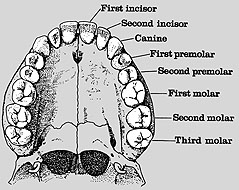Our Infraorder Simiiformes (Anthropoids) is divided into two Parvorders (Platyrrhini and Catarrhini).


The Platyrrhines are the New World Monkeys (Neotropical Monkeys). Platyrrhines live in South and Central America, are all primarily arboreal, and show great diversity in social structures.
Platyrrhini include: marmosets, tamarins, squirrel monkeys, capuchins, owl monkeys, titi monkeys, howler monkeys, spider monkeys, woolly monkeys, muriquis, sakis, and uakaris.
The Catarrhini consist of two Superfamilies – Cercopithecoidea (Old World Monkeys) and Hominoidea (Apes). Cercopithecoids live in Africa and Asia (one species of macaque lives on the island of Gibraltar), have diverse styles of locomotion (some are arboreal, some are terrestrial, some are both).
Catarrhini include: colobus monkeys, proboscis monkeys, golden monkeys, langurs, leaf monkeys, baboons, macaques, geladas, guenons, mandrills, gibbons, orangutans, gorillas, chimpanzees, and humans.
Unique Dental Traits
Dental Formula
Primates have a generalized dentition, meaning that we have different types of teeth that serve different purposes – incisors, canines, pre-molars, and molars. Primates in different taxonomic categories have different numbers of the tooth types, notably the pre-molars.
We can calculate and analyze the different dental formulas by writing down the number of each type. To do so, you’ll look at one quarter of the mouth – choose either the maxilla or mandible, then starting from the midline, count the teeth from the front to the back. Homo sapiens have 2 incisors, 1 canine, 2 pre-molars, and 3 molars. So our dental formula would be written as 2.1.2.3. With few exceptions, members of the infraorder platyrrhines have 2.1.3.3 dentition, while catarrhines have 2.1.2.3.


Canine Honing
It is important to note that unlike carnivores, in primates, the main function of the canine teeth is not for food consumption. Rather, primates who exhibit excessive sexual dimorphism use their larger canines to engage in competition and displays. In these species with larger canines, a canine honing complex is present, in which the upper and lower canines rub against one another so that the canines can sharpen each other.
When this happens, a groove is formed on the upper canine, where the lower one has worn it away.


Canine Diastema
In primates who do have such large canines, a space is often needed in order to allow the large canines to nest, or fit within the dental arcade. In general, we tend to see the presence of a canine diastema in groups who exhibit higher degrees of sexual dimorphism.

Carefully look at the skulls and fully articulated skeletons of the two individuals below, and fill out the accompanying table. Note the following characteristics that distinguish NWM from OWM.


Reflection Questions
Which of the above characteristics would preserve best in the archaeological record?
Compare the prehensile tail to your fingers and note the similarities. What would be its selective advantage over a common tail?